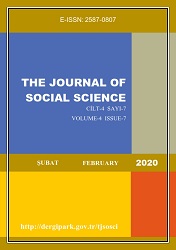KÖL TİGİN (K 10) YAZITINDAKİ ÖD T(E)NRİ RSY KİŞİ OGLI KOOP ÖLG(E)Lİ TÖRİM(İ)Ş CÜMLESİ ÜZERİNE
UPON THE SENTENCE OF KOL TIGIN (K 10) INSCRIPTIONS ÖD T(E)ÑRİ RSY KİŞİ OGLI KOOP ÖLG(E)Lİ TÖRİM(İ)Ş
Author(s): Eyup Sertaç AyazSubject(s): Semiotics / Semiology, Ancient World, Syntax, Historical Linguistics
Published by: Dicle Üniversitesi, Sivil Havacılık Yüksekokulu
Keywords: Kol Tigin Inscriptions; Tanrı; time; ysr;
Summary/Abstract: It was observed that the word RSY (ysr) in the 10th line of the northern facade of Köl Tigin inscription was read in different ways as „yaşar‟, „yasar‟ and „aysar‟. Due to these reading differences, different meanings are given to the sentence in which the word takes. Studies presenting the copy of the inscriptions are in agreement for the signs in the word RSY (ysr). It is understood that the reason of the differences in reading is not related to the differences in signs, it is related to the preferences in meaning. There is also no unity in the meaning of the expression „öd täŋri‟ at the beginning of the same sentence. For the correct understanding of the sentence in the inscription, the subject should be examined in detail in the light of the Turkish religious history. Bilge Kaghan, the Turkish kaghan, who took the source of his political power and domination from Tanrı, made a determination summarizing the Turkish belief system with this sentence. In this article, the word RSY (ysr) is re-examined based on the belief system shaped on the basis of Gök Tanrı, by examining the previous reading and interpretation proposals.
Journal: The Journal of Social Science
- Issue Year: 4/2020
- Issue No: 7
- Page Range: 219-225
- Page Count: 7
- Language: Turkish

